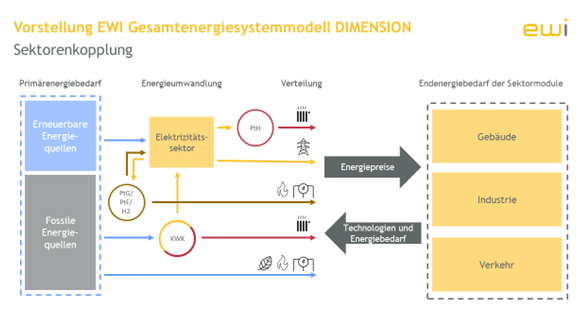Sector coupling is about connecting the energy sector with the industry, transport, and building sectors and then optimizing them together. According to this concept, if all sectors are interconnected, then CO2 emissions can be reduced with renewable energies. Thereby, storage technologies can balance out the volatile renewable energies.
There has already been some progress towards sector coupling in the energy sector in Germany: the share of renewable energies in electricity consumption is increasing, CO2-intensive coal-fired power generation is being gradually reduced and will end in 2038 at the latest. The national hydrogen strategy also paves the way for the use of carbon-neutral fuels in the consumption sectors.
In the three so-called consumption sectors of industry, transport, and buildings, there has been little progress in decarbonization, i.e., the reduction of greenhouse gases. Up to now, a considerable amount of fossil fuels has been used in these sectors, and CO2 emissions are consequently high. To emit fewer greenhouse gases, these three sectors must switch more strongly to renewable energy sources. CO2 emissions can only be reduced sustainably if industry, transport, and buildings are considered and optimized together. That is where sector coupling comes in with two strategies.
The total energy system model DIMENSION developed by the EWI allows the entire European energy system to be considered. For example, the model can be used to determine the optimal short- and long-term supply costs for electricity, heat, and synthetic fuels in the overall European system across sectors. Interdependencies, as well as political, regulatory and technological framework conditions, are taken into account.
For example, demand for electricity in the transport sector increases overall demand and electricity price. The latter, in turn, causes lower market penetration. Prices, technologies, and energy demands are thus links between the different sectors. Throughout themodeling, the consumption sectors buildings, industry, and transport are mapped in detail and included in the cost optimization.

The EWI develops and compares transformation pathways towards Germany’s climate policy goals for 2050, working on many projects in close cooperation with partners from all sectors, politics, society, and science.
Indeed, Germany could significantly reduce greenhouse gas emissions if greater efforts were made in all sectors. To achieve this, renewable energies would have to be expanded and better integrated. Final energy consumption would have to be reduced through comprehensive energy efficiency efforts, and synthetic energy sources would have to be used on a large scale. A broad mix of technologies and energy sources would enable a more cost-effective and robust transformation of the energy system than complete electrification.
On the way to the politically targeted climate neutrality by 2050, all sectors must significantly reduce emissions – all the way to “net-zero”. The EWI is researching the role played by new political, economic, and social framework conditions, such as hydrogen as an energy carrier. It also analyzes the impact of the European Commission’s “Green Deal” on national climate targets and the challenges concerning the technologies required.
Within the framework of expert opinions and studies, the EWI works on developing climate-neutral, innovative and integrated scenarios for the energy transition. The aim is to create consistent development paths across sectors, which serve as a basis for corporate and political decisions.